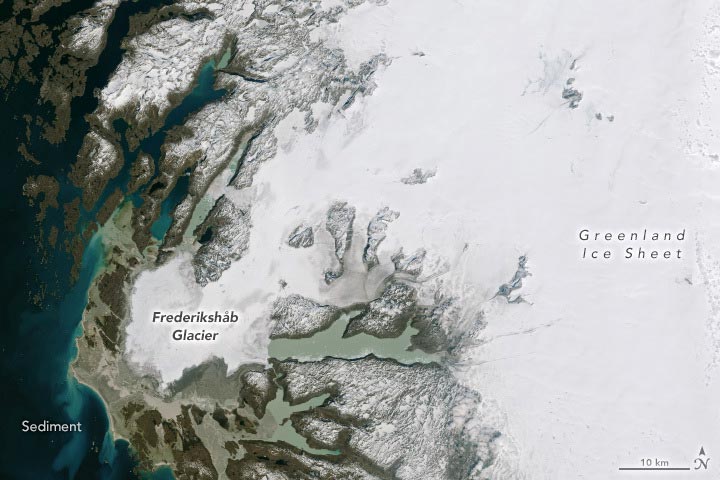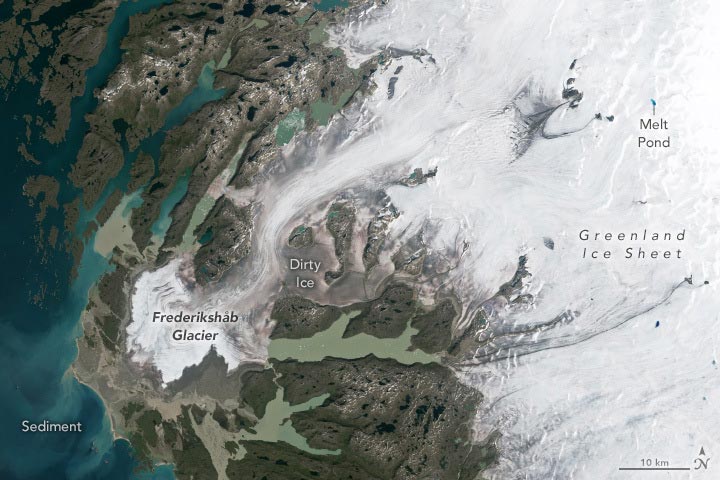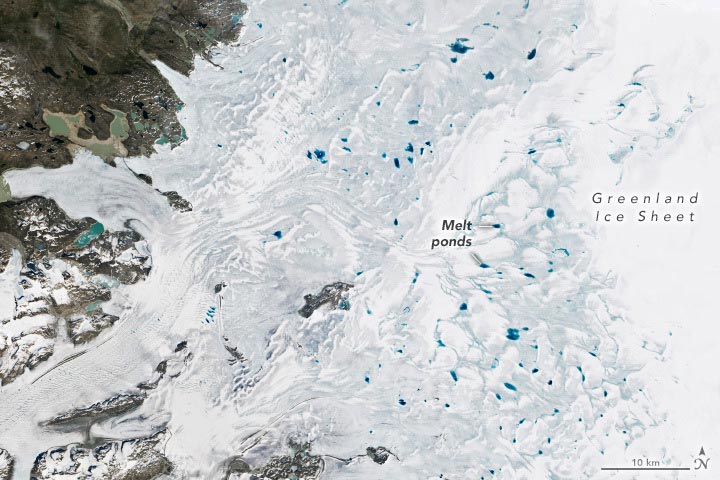

Warm weather caused substantial melting in June and July 2023, especially on the southern portion of the island.
More than halfway through the 2023 melting season, G a significant transformation of Greenland’s snow cover has been observed. There has been above-average melting throughout most of the season. Notably, on several days in June and July, melt was detected across up to 50 percent—equivalent to 800,000 square kilometers (302,000 square miles)—of the Greenland Ice Sheet’s surface. This is according to data comes from the National Snow and Ice Data Center.
The Impact on Frederikshåb Glacier
Summer melting was ramping up on June 14, 2023, when Landsat 8’s Operational Land Imager (OLI) acquired this image (top) of Frederikshåb Glacier. This lobe-shaped piedmont glacier, located in southwest Greenland, flows downward from the Greenland Ice Sheet, winds past a series of valleys and nunataks, then flattens out on smoother terrain along the coast.
The other image (lower), acquired with the OLI-2 on Landsat 9, shows the same area on July 24, after more than a month of additional melting. There is a dramatic reduction in the extent of brighter (high albedo) surface snow that is easily noticed.
Increased Monitoring Capabilities With Landsat 9
Since September 2021, when Landsat 9 joined Landsat 8 in orbit over Earth, scientists have been getting more frequent detailed views of Earth. The Landsat 8 and Landsat 9 satellites together acquire about 1,500 scenes from across the planet every day. That comes in handy for observing the planet’s icy regions, where seasonal changes can be quick and dramatic.
Transition From “Clean” Snow to “Dirty” Ice
Another seasonal change visible in the image pair above is the transition from “clean” snow to “dirty” ice. One reason for the darker color is due to the presence of particles, such as black carbon or dust, that have accumulated on the ice. As the snow and ice melt, these impurities are left behind. Darkening of the ice surface lowers its albedo, which can hasten melting through the absorption of additional solar energy in the summer months.

Appearance of Melt Ponds
Another noticeable change is in the emergence of ponded water, or “melt ponds,” on the surface of the ice sheet. Deep blue in color, they form where snow has melted and pooled in low spots on the ice sheet’s undulating topography. They can be an important indicator of the strength of Greenland’s melting season, which generally runs from May to early September.
Only a few melt ponds are visible in the July 24 image (top-lower), possibly because meltwater had already run off the ice sheet or been channeled down through the ice. However, abundant melt ponds were visible about 100 kilometers (60 miles) north of Frederikshåb on July 8, when the OLI-2 on Landsat 9 acquired the image above.
Impact of Seasonal Weather Changes
These transformations are consequences of the increase in summer warmth that set in across the region in late June. At that time, warm southwesterly winds and clear skies significantly intensified the amount of melting on the ice sheet, especially towards the island’s south.
Comparison With Previous Melting Seasons
So far in Greenland’s 2023 melting season, spikes in daily melt area have stayed below those of 2012, a year with exceptionally widespread melting. Still, as of mid-July, daily melt extents have been consistently higher than the 1981-2010 average, and 2023 is on par with several other high melt years in recent decades.
“The drama of unprecedented melt in 2012 may not be exceeded this year,” said Christopher Shuman, a University of Maryland, Baltimore County, glaciologist based at NASA’s Goddard Space Flight Center. “But so far, 2023 looks to be a big, broad melt year.”
NASA Earth Observatory images by Wanmei Liang, using Landsat data from the U.S. Geological Survey.
Never miss a breakthrough: Join the SciTechDaily newsletter.
7 Comments
“Darkening of the ice surface lowers its albedo, which can hasten melting through the absorption of additional solar energy in the summer months.”
The operative word here is “can.” However, people trekking on glaciers often observe pebbles (even black meteorites in Antarctica) sitting atop an ice pedestal. The pebbles and boulders shade the ice, retarding melting from direct sunlight. At former Camp Tuto, near Thule AFB, one can observe the snout of the glacier, armored with glacial till, in what CRREL glaciologists dubbed shear moraines; it retards the melting because the rocks absorb the sunlight. The glaciologists had the good fortune to be able to observe the ice in cross-section in the tunnel made by the Army, recognizing that the ice can be deflected upwards by irregularities in the topography under the ice, delivering the ground moraine to the surface.
As great as remote sensing is, there is no substitute for direct observations and sampling on the ground. One of the problems we have with science today is that scientists are often too enamored with computer models and remote sensing, and neglect the ground-truth.
“Only a few melt ponds are visible in the July 24 image (top-lower), possibly because meltwater had already run off the ice sheet or been channeled down through the ice.”
Something that isn’t appreciated by anyone who hasn’t been to Greenland in the Summer, is that even when ponds or surface streams aren’t visible, there is considerable meltwater below the surface, [even in 1967] and more importantly, held in the snow on the surface. It is similar to what we commonly call slush — more akin to a snow cone than solid ice. An Arctic Fox can walk on the surface, but a human, without snowshoes, will sink down at least a 1/2 meter, as I learned from personal experience. Again, that is something that isn’t obvious from exclusively relying on remote sensing imagery.
Iceland’s ice sheets have melted AND refrozen numerous times before, and WILL do so again. This event, like every other event in Nature, is NATURALLY-OCCURING.
“But so far, 2023 looks to be a big, broad melt year.”
“At that time, warm southwesterly winds and clear skies significantly intensified the amount of melting on the ice sheet, especially towards the island’s south.”
Which is it?
I’d like a definition of “substantial” as used by the author, inasmuch as she also said, “So far in Greenland’s 2023 melting season, spikes in daily melt area have stayed below those of 2012, a year with exceptionally widespread melting.”
Isn’t it true that every 12-15 years there’s a seasonal change to the climate and the fact the Sun at times shines stronger than other times and therefore also affect the weather and wind pattern on the globe in general?
If we go back in time like during the Viking Age, there is obviously a reason for why it was called Greenland in the first place right?
A few years ago in the mountains of Norway, an icecap started to melt and with it uncovered an old viking road or passage between two valleys used on a daily basis. Then the climate got colder and subsequently covered the area with snow and ice to eventually melt again some 1000+ odd years later.
I remember the Summers of 75-78 back in Sweden where it was so hot the tarmac melted and then in the early 1980s the south part of Sweden had so much snow it lasted for month.
So yea some years the ice melts quicker but then come winter and thing changes again. I mean it was only a month or so ago it was snowing in the North of Norway.
“If we go back in time like during the Viking Age, there is obviously a reason for why it was called Greenland in the first place right?”
It may have been a marketing spin to encourage colonists. 🙂
if you got each ton of ice (approximately 1metre cube) that was leftover from from last years summer melt(600 gigatons of snow fell during the winter, approximately 440 gigatons survived) compressed into 1 ton blocks of ice and stacked on top each other, that stack would stretch to the sun 3 times.